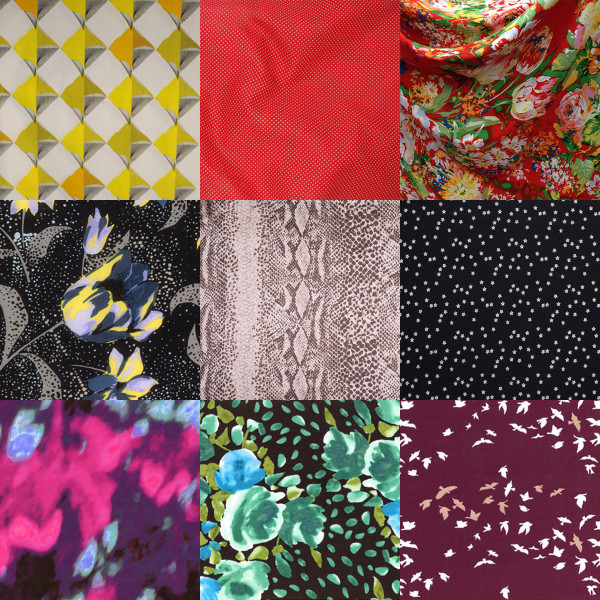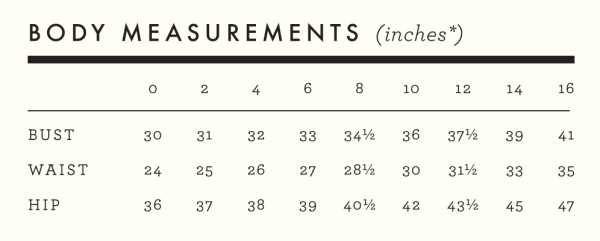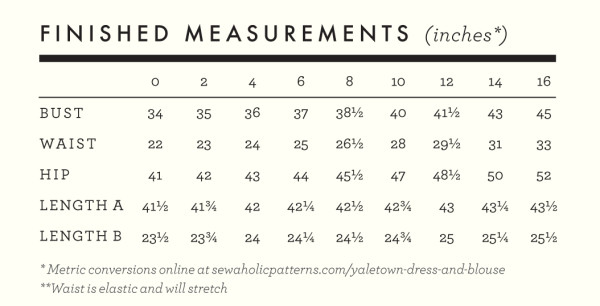Happy Monday everyone! In this post, we’ll talk about fabric suggestions, choosing a size and FAQ’s about our Yaletown pattern.
Fabric Suggestions
We recommend a fabric with drape to get the best results. Drape refers to how the fabric hangs, not the weight of the fabric. A good test of drape is taking a width of fabric and gathering it up in your fist. Does it bag out or have large stiff folds? Then it probably isn’t a drapey fabric. Fabrics with drape will fall smoothly and flow naturally. If you hold the gathered piece of fabric along your hips, and it skims your body, then I would consider it to have drape. If it sticks out from your body and appears crisp or more structured, then it likely does not have the drape you want for this dress or blouse.
Some fabrics with drape cold be rayon challis, charmeuse or satin, crepe, cotton lawn, or cotton voile. But if you are in the fabric store, don’t concern yourself too much if you fall in love with a fabric that is not listed above. If it is opaque, lightweight to midweight, and drapes fluidly against your body, then it should work!
Here are some examples of fabrics that would be lovely paired with the Yaletown dress or blouse.
Choosing a Size
Sometimes, looking at a size chart with body measurements, and finished garment measurements, it can be tough to decide which size to choose. The first thing you need to do is measure your body. The measurements you’ll need most importantly are bust, waist, and hips. Compare your measurements with the body measurements on the back of the pattern envelope, or in the downloadable instructions if you purchased a PDF pattern. Here they are:
If you fit perfectly into one size column, then yay! Go with that size.
If you don’t fit into one size column, then you may be able to select just one size anyways. If your bust and waist match a size 10 for example, but your hips are smaller, you can still cut a size 10. The gathered skirt will still skim your hips if you choose a fabric with drape.
Also, remember that the waist of this dress is gathered with elastic. This will work to our advantage! If your bust and hips fit into one column, but your waist is smaller, then you can use a smaller length of waist elastic than recommended to make it a bit more snug.
Another thing to consider is your bust “cup size”. Sewaholic Patterns are designed for a B cup. It’s important to keep in mind that your cup size in pattern making may be different from your bra cup size. To figure out if you are a B cup, start with your bust measurement. Then measure your high bust (for this, measure above your bust, running the tape measure just under your arms). If the difference between these two is more than 2” (5 cm), then you are larger than a B cup.
So what if you are larger than a B cup? With the loose fit and style of this dress, you may still be able to get away with not doing a full bust adjust (FBA). Check the finished measurements for the bust. Note that we give 4″ of ease at the bust for this pattern, which is generous! If you fit within the finished measurement, make a quick muslin of the bodice without any changes to check the fit. If you find it snug around the bust, then a FBA is likely the answer. Tune in later this week for more on how to do that!
How about grading between sizes? I talk about the basics of grading between sizes in the Gabriola sew-along here.If you decide you want to grade between sizes, it won’t be difficult with this pattern. Because there are no darts or closures, you will only need to blend between sizes along the side seams.
FAQ
You guys asked some great questions! Here are some of the popular topics that came up.
Changing the sleeves.
It will be more difficult to change this sleeve than most sleeve patterns, since it is a flutter shape, and it has gathers at the sleeve cap. It is much easier to create a flutter/gathered sleeve, than it is undo it. However, it can be done! Here are a couple of ways you can give it a go:
- Reverse engineer the sleeve back to a regular sleeve. Here is a great article about drafting different types of sleeves. She explains how a gathered sleeve cap is drafted, as well as a flutter sleeve (or bell sleeve). You can do the reverse to remove the fullness from the gathers and flutter. From here you can leave it as a short sleeve, or lengthen it to elbow or full length!
OR
- Find a sleeve pattern that you like on a bodice that fits you. Compare the armholes from that bodice and the Yaletown bodice. You will more than likely have to redraw the Yaletown bodice armhole to match your chosen sleeve piece.
Lining the dress.
Totally do-able! However with the wrap style, lining the bodice the traditional way would be tricky. I would recommend lining the skirt, and underlining the bodice.
- The skirt lining piece will be an exact replica of the skirt piece, except shortened by about 1/2″ – 1″, depending on your preference. In terms of construction, I would sew the skirt lining as a separate piece. Attach it to the skirt along the waistline before you join the skirt to the bodice.
- The bodice front and back pieces pieces can be underlined and then sewn as per instructions.
Can it be made in a knit fabric?
The short answer – probably! However I have not tried it myself. My advice:
- Be sure to use a stable knit fabric.
- You may want to go down a size or two to get a nice fit, especially if your knit fabric has a high spandex content.
- Facings in a knit fabric are not ideal. It would be a good idea to try finishing your neckline another way, like with a neck band or knit binding.
And remember! For any of these major adjustments, we always recommend making a quick muslin to pinpoint any fit issues before cutting into your beloved fabric.
P.S. I will be back on Thursday to talk about bust adjustments!




Hi Caroline! So, I made up a wearable muslin of the Yaletown and seem to have an excessive amount of blousiness in the bodice… I don’t think it’s a size issue, as the bust and shoulders fit well, just not the area under the bodice but above the waistline. Do you think shortening the bodice would help? Here’s my version of the Yaletown, so you can see what I am talking about! Thanks in advance for any advice you might have! http://cookinandcraftin.blogspot.com/2014/08/polka-dot-yaletown-blouse.html
Hi Meg! Yes, I think shortening the bodice should reduce some of blousiness. You could also try to grade down a size at the waist, just blend from the bust down to the waistline and be sure to match that size in the skirt or lower bodice pieces. This will reduce some of the gathers for you and therefore reduce some of the blousing.
That should help! Good luck :)
Thanks so much! I think I will try pinching out some of the length on the bodice on this one to see what happens, then for my next version I’ll try the grading down suggestion.
Hi! Just a note to the weight vs drape – by coletterie, and the trouble recognizing the different types of fabrics.
-Just remember that the secret often lies in the binding, the way it is weaved. Ex: Satin is called that because it is weaved in a satin binding. If you dive into the weaves of textile, the knowledge will keep you on top of the roll.
Confused here….
The printed ‘finished measurements’ for the waist are smaller than the body measurements for the waist, per given size?
Hi Sabine! The finished measurements for the waist are smaller because the waist is elasticized. It will stretch! :)
Hi! This is more a fabric question than a yaletown question if that’s OK. In patterns where shirting is a suggested fabric (I think that’s a suggestion for Alma blouse and belcarra blouse), should I still be considering drape? My local retailer has lots of thin crisp stiff cottons, but is this what you would describe as shirting, or should I be looking for something more like chambray?
Hi Sonia! It’s really up to you and the look you want to achieve. Typically when I think of a shirting, I think of a lightweight cotton or cotton blend with a somewhat stiff drape. So what your local retailers has is probably what I would also consider a shirting. Chambray does tend to be a little bit drapier in some cases. But a lot of blouses could work in both a stiffer shirting or a drapier chambray, so it depends what you’re going for.
Hope this helps!
Many thanks Caroline, I will experiment and see, but glad I’m going in the right direction. Happy holiday :-)
Hi Caroline,
I just ordered the yaletown pattern and want to make a dress. I have been hoarding a piece of very very nice summer-weight suiting wool for a long time and I am wondering if you think it would work? It has great drape, amazing actually but it is heavier than a typical rayon challis or charmeuse. Its the type of fabric that would make wide-leg trousers that Katharine Hepburn would wear. Thanks for your help!
Hello!
I’m currently making three of these as bridesmaids dresses! (Gulp!)
One of the bridesmaid’s measurements are:
UB 34″
B 31″
W 28″
H 38″
I really can’t decide what size to cut. I’d SO appreciate some help from anyone!
Thank you!
Hey Ellen! Sorry for the delayed reply, I’ve been on holiday and just returned! For the Yaletown (and most dress patterns) I’d choose a size based on the bust, since the waist is elastic and easy to adjust, and the hips have a lot of ease in the skirt. It’s most important to get a good fit in the bust and shoulders. If the bridesmaid is a C-cup and up, choose by the high bust (taking the measurement above the bust, to measure the upper chest), otherwise, choose by the full bust measurement. More tips on choosing a blouse size here – http://sewaholic.net/pendrell-sew-along-measuring-and-choosing-your-size/ – and good luck! Three bridesmaid dress is a big project, but luckily if they’re all the same pattern it will get easier with each one. :)